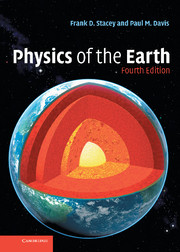Book contents
- Frontmatter
- Contents
- Preface
- 1 Origin and history of the Solar System
- 2 Composition of the Earth
- 3 Radioactivity, isotopes and dating
- 4 Isotopic clues to the age and origin of the Solar System
- 5 Evidence of the Earth's evolutionary history
- 6 Rotation, figure of the Earth and gravity
- 7 Precession, wobble and rotational irregularities
- 8 Tides and the evolution of the lunar orbit
- 9 The satellite geoid, isostasy, post-glacial rebound and mantle viscosity
- 10 Elastic and inelastic properties
- 11 Deformation of the crust: rock mechanics
- 12 Tectonics
- 13 Convective and tectonic stresses
- 14 Kinematics of the earthquake process
- 15 Earthquake dynamics
- 16 Seismic wave propagation
- 17 Seismological determination of Earth structure
- 18 Finite strain and high-pressure equations of state
- 19 Thermal properties
- 20 The surface heat flux
- 21 The global energy budget
- 22 Thermodynamics of convection
- 23 Thermal history
- 24 The geomagnetic field
- 25 Rock magnetism and paleomagnetism
- 26 ‘Alternative’ energy sources and natural climate variations: some geophysical background
- Appendix A General reference data
- Appendix B Orbital dynamics (Kepler's laws)
- Appendix C Spherical harmonic functions
- Appendix D Relationships between elastic moduli of an isotropic solid
- Appendix E Thermodynamic parameters and derivative relationships
- Appendix F An Earth model: mechanical properties
- Appendix G A thermal model of the Earth
- Appendix H Radioactive isotopes
- Appendix I A geologic time scale
- Appendix J Problems
- References
- Name Index
- Subject Index
21 - The global energy budget
Published online by Cambridge University Press: 05 July 2013
- Frontmatter
- Contents
- Preface
- 1 Origin and history of the Solar System
- 2 Composition of the Earth
- 3 Radioactivity, isotopes and dating
- 4 Isotopic clues to the age and origin of the Solar System
- 5 Evidence of the Earth's evolutionary history
- 6 Rotation, figure of the Earth and gravity
- 7 Precession, wobble and rotational irregularities
- 8 Tides and the evolution of the lunar orbit
- 9 The satellite geoid, isostasy, post-glacial rebound and mantle viscosity
- 10 Elastic and inelastic properties
- 11 Deformation of the crust: rock mechanics
- 12 Tectonics
- 13 Convective and tectonic stresses
- 14 Kinematics of the earthquake process
- 15 Earthquake dynamics
- 16 Seismic wave propagation
- 17 Seismological determination of Earth structure
- 18 Finite strain and high-pressure equations of state
- 19 Thermal properties
- 20 The surface heat flux
- 21 The global energy budget
- 22 Thermodynamics of convection
- 23 Thermal history
- 24 The geomagnetic field
- 25 Rock magnetism and paleomagnetism
- 26 ‘Alternative’ energy sources and natural climate variations: some geophysical background
- Appendix A General reference data
- Appendix B Orbital dynamics (Kepler's laws)
- Appendix C Spherical harmonic functions
- Appendix D Relationships between elastic moduli of an isotropic solid
- Appendix E Thermodynamic parameters and derivative relationships
- Appendix F An Earth model: mechanical properties
- Appendix G A thermal model of the Earth
- Appendix H Radioactive isotopes
- Appendix I A geologic time scale
- Appendix J Problems
- References
- Name Index
- Subject Index
Summary
Preamble
If the Earth's internal heat were not maintained by radioactivity, the present rate of heat loss, 44.2 × 1012 W, would cause cooling at an average rate of about 120 K per billion years. Even over 4.5 billion years, cooling at this rate would have had only a moderate effect on the temperature of the deep interior. Although radioactivity is the dominant continuing source of internal energy, it is only topping up the primordial heat generated by the Earth's accretion. It is slowing the cooling rate but is not the reason why the interior is hot. But radioactivity is decreasing slowly with time and does not balance the heat loss. The Earth is cooling at a rate determined by the difference between the surface heat flux and the radiogenic heat. Mantle convection and tectonics are slowing down as the Earth cools and the rate of change is determined by this unbalance.
A substantial source of internal energy is necessary also to maintain core convection, which drives the geomagnetic dynamo. The Earth has had a magnetic field for at least 3.5 billion years and probably for its entire life. The power requirement for dynamo action is probably less than the drain on core energy by thermal conduction, and if the core has some radioactivity then its effect is to compensate for the conductive heat loss. The necessity for this depends on the core conductivity, which is still poorly determined.
- Type
- Chapter
- Information
- Physics of the Earth , pp. 348 - 360Publisher: Cambridge University PressPrint publication year: 2008
- 1
- Cited by



